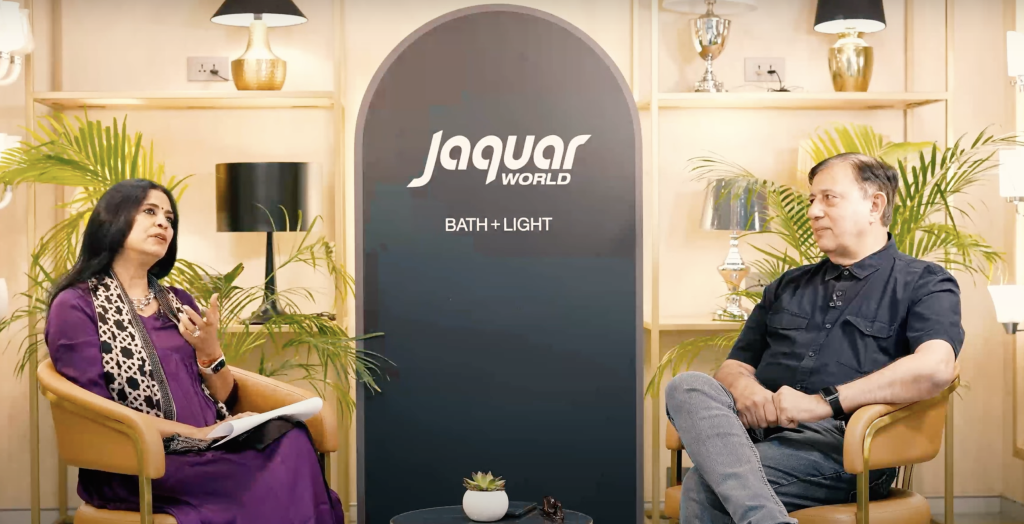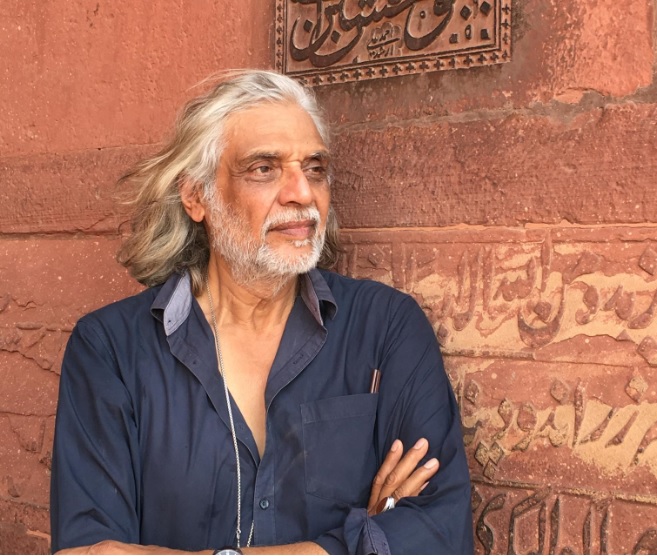Welcome to Samvaad, where art meets conversation, and inspiration knows no bounds. Here we engage in insightful conversations with eminent personalities from the art fraternity. Through Samvaad, Abir Pothi aims to create a platform for thought-provoking discussions, providing readers with an exclusive glimpse into the creative processes, inspirations, and experiences of these creative individuals. From curating groundbreaking exhibitions to pushing the boundaries of artistic expression, our interviews shed light on the diverse perspectives and contributions of these art luminaries. Samvaad is your ticket to connect with the visionaries who breathe life into the art world, offering unique insights and behind-the-scenes glimpses into their fascinating journeys.
In the lively city of Surat, nestled in the western Indian state of Gujarat, a rich history of commerce, and culture weaves its way through bustling streets and modern skylines. In this intriguing dialogue (Samvaad), Ruby Jagrut, founder of Abir India Charitable Trust and an esteemed artist, engages in conversation with Sanjay Punjabi, a prominent figure in Surat’s design and art community. Together, they embark on a journey through Surat’s multifaceted identity, exploring its historical significance, artistic endeavours, and entrepreneurial vigour. From the evolution of Surat’s textile industry to its pivotal role in global finance, Sanjay shares insights on how art, innovation, and commerce intersect in this vibrant metropolis. Through anecdotes, historical perspectives, and reflections on contemporary trends, this dialogue offers a captivating glimpse into the essence of Surat and its enduring legacy on the world stage.
Ruby: Hello and welcome to Samvaad. Today, from Surat, we are going to talk to Mr. Sanjay Punjabi, an engineer by qualification and a designer with passion. Sanjay has a wonderful journey to share with us. He’s not only a designer but also a changer who has transformed the city’s landscape with his passion for art, film, and books. Welcome, Sanjay! Welcome to Samvaad. We are happy that you have given us time for this. You know, you have an illustrious career to talk about, different facets of your personality. I am now confused about where to start, but let’s begin with how you transitioned from being an engineer to a designer, and then we’ll take it forward.
SP: Yeah, okay, so I started my journey in the 1990s when I began my practice. In the initial phase, like every designer or entrepreneur, survival is key. So, during the first few years, the focus was on settling down and understanding the field. At that time, there was no formal education related to interior design. We, along with some seniors and good friends, started formulating dialogues, organising meetings, and developing a curriculum on how to proceed further. The first phase of my journey was about settling down and making contributions related to design. Perhaps our significant contribution was in collaborating with individuals from various other cities to establish education programs for interior design, which was quite satisfying. It was during this time that we began to understand that there is more to interior design than just aesthetics. We explored how art could be integrated into practice and daily life. That was the first lesson I learned.
Ruby: You have a strong belief that architecture cannot happen without art and that the presence of art will always enhance architecture and your interior design practice. So, it’s been there from the beginning, that’s what you’re saying. How did you introduce that into your practice? The most important question is, how did you convince people of your belief? Most of the time, we hear”Oh, we believe in art and we want to have art as an integral part of our project,” but the clients are not agreeing to it. They don’t understand art and are not able to accept it. So, how did you manage to do that?
SP: So basically, I was born and brought up in Vadodara, and the fabric of that city was altogether different. Being in Surat as my karma bhumi, imbuing art into practice was a difficult task. Surat, at that time, had few interior designers, and very few selected projects were happening there. People were quite satisfied with the new materials, technology, and ways of working. The cake was prepared, but the icing on the cake, which I call art, was missing. So, slowly and gradually, we began to have dialogues with numerous people. The good thing was that parallel to the interior design field, artists were also struggling at that time. There were quite a few, but they were quite interesting. I mean, if I talk about the Smart family or Rohit bhai and other people, they were equally talented compared to artists from other cities, but they were not being focused on or invited by interior designers at that time. Very few of them were. So, this started happening around the period from 1995 to 2002, when this merging and collaboration began to take place informally. Surat started recognizing art in various forms within architecture, and this was appreciated by many. Surat is very keen on picking up trends, so this trend picked up from 2002 onwards and continued into the second decade of the 21st century.
Ruby: Of course, Surat being one of the fastest-growing cities in India and also one of the most economically strong cities, there are indeed more possibilities for collaboration, both in terms of public and private sectors, including public spaces. I’m jumping to public spaces because I believe that in your projects, art is an integral part. But how do you see Surat as a city as a whole? Where do you think this quick and sudden growth of Surat has led to losses, and what would you like to see? How do you envision public spaces in Surat in the past and the future?
SP: If I tell you, it’s a very interesting journey. Being Gujarat considered an entrepreneurial city and Surat as the financial capital of Gujarat, Surati Lalas were not traditionally inclined towards art, but that was not entirely correct. When we look back, as I’m a co-convenor of INTACH, the largest foundation in India, we come across the legacy and art history related to Surat. I’ve always believed that talents and skills are geographically equally distributed, so one cannot monopolize certain cities like Bangalore for startups or assume that only certain cities know about art. There are artists in every part and corner of every city. When we started meeting different people, we discovered this. We initiated the first movement related to art way back in 2005, focusing on films. A few friends came together and had conversations with the FFSI, the Film Federation Society of India set up by Satyajit Ray. This movement about art was well appreciated. We screened many films and were also involved in experimental plays like “Tumhari Amruta” and similar ones. As people started coming and discussing, we realized there was a hunger for art within the city. We tried to recognise it, boost it, and channel it into various initiatives. One such initiative was Tapi Utsav, where all artists came together. We collaborated with them, showing how beautifully it could be done.
So, in 2011, certain things started happening. The Film Society of Surat was at its peak, and various groups on Facebook started emerging, including a 24-hour chat room. There was a small group called Drishtikon that used to meet every Sunday at 5:00 a.m. One fine morning, I suggested meeting the founder or key person in this chat room. I vividly remember it was almost March 9, 2011, when we decided to meet at Hotel Center Court. One person arrived and sat at one table, while I sat at another. We didn’t have profile pictures on Facebook at that time, which caused some confusion. Eventually, another friend arrived, and they knew each other. We started discussing whether we could do something related to amateur photography as an art.
We decided to organize an event on August 13th, 14th, and 15th, 2011, giving us 111 days to plan. We could take 11 days to decide whether it was feasible, but we proposed the idea of having amateur photography as an art exhibition, which had never been done in Gujarat. After having coffee, we unanimously decided to proceed with a Drishtikon exhibition of art. This event became a turning point for Surat.
One of the founders, Sourabh Desai, who was then working with L&T, decided to leave his job and pursue films and photography as his main profession. Some friends from Drishtikon joined him, and in 2011, from August 13th to 15th, we witnessed the display of more than 2,000 amateur photographs in various categories. This event changed the perception of photography as an art in Surat. It served as a benchmark and a turning point, inspiring many young photographers to take up photography as a serious profession. Since then, regular events have been happening.
Immediately after 2011, there was a girl named Ritu who was struggling to convince government departments to fund the showcasing of original art by artists awarded by the government. They wanted to display the artists’ creations and demonstrate their artistic process. Along with Ritu and a few friends, we floated the idea of Tapi Utsav at the Chamber of Commerce, which was one of its kind. For those who witnessed Tapi Utsav, it was a turning point for art, particularly during 2011-12.
During Tapi Utsav, 45 speakers attended. We convinced the Surat Municipal Corporation (SMC) that the Science Center foyer should be dedicated solely to art. We organised events like the morning Raga at 5:30 a.m., IPTA performances, and appearances by Paresh Rawal and Amrit Gangar. Art was displayed at its peak, reaching all strata of society. People participated in workshops on various art forms like origami and clay, learning a lot about art. After Tapi Utsav, Surat was divided into the 21st century before and after the event. It brought about significant changes, empowering the community with exposure to and participation in art.
To be continued….





